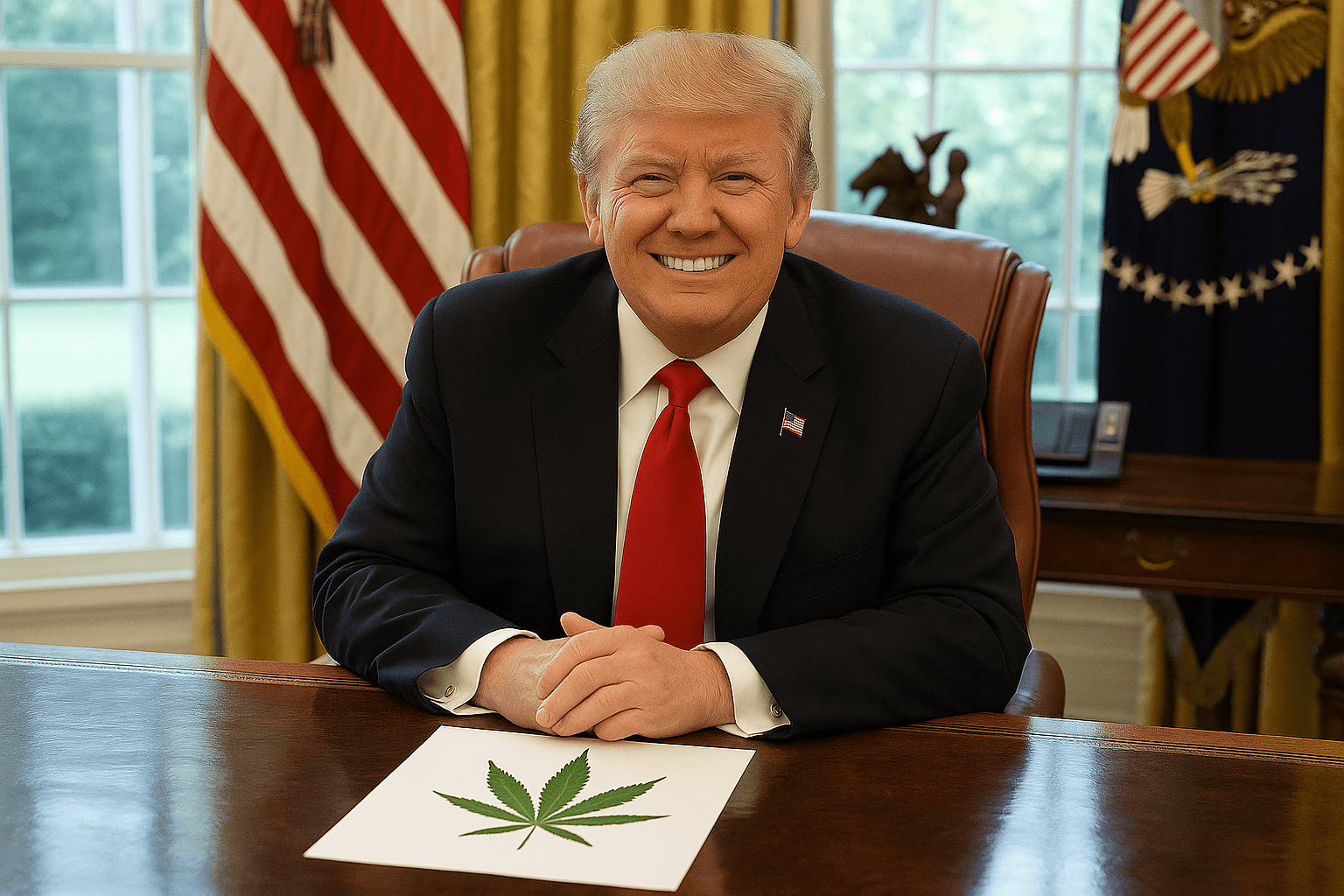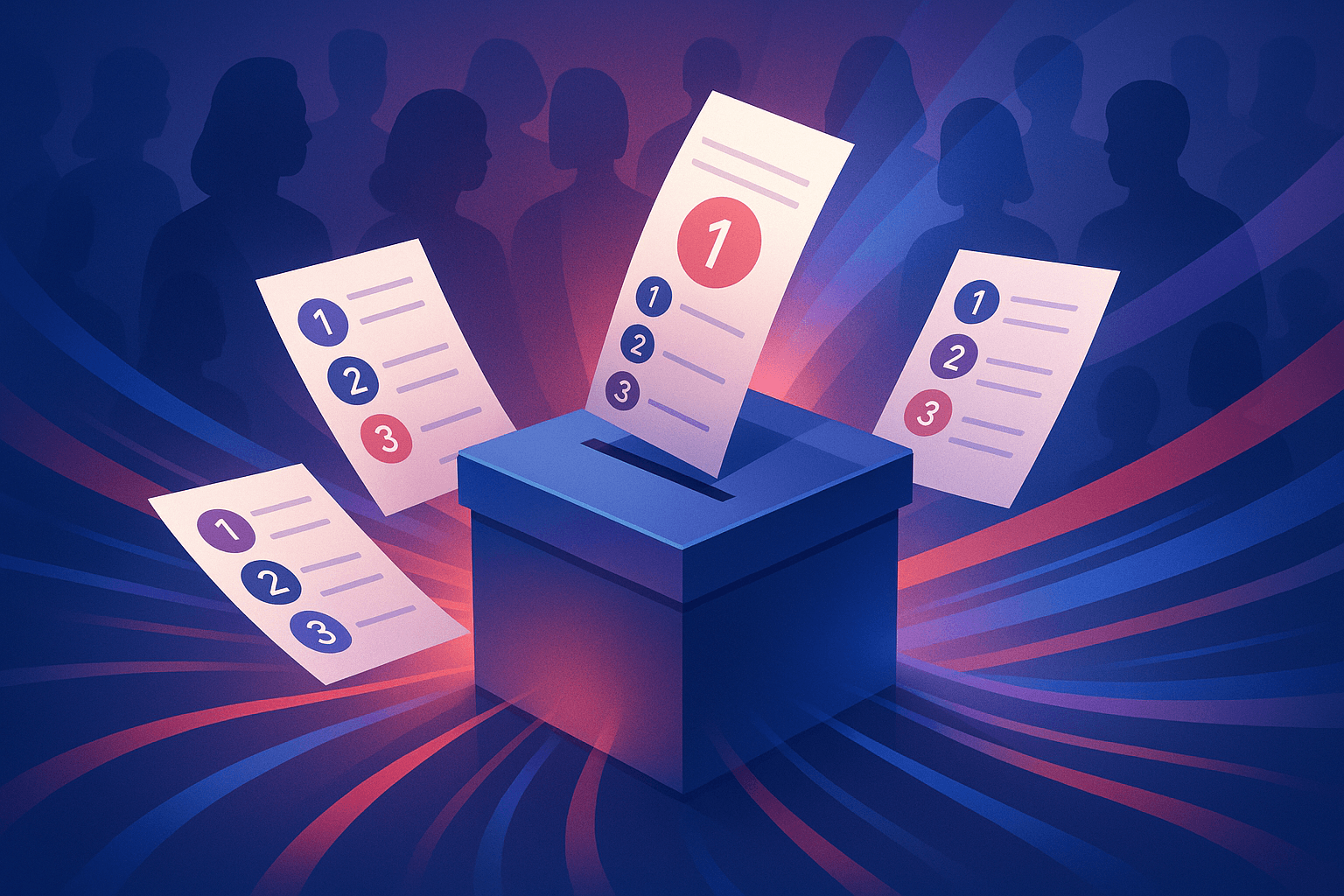Almost Zero Competition in Our Political Parties, But New Bill Could Change That

Competition is the American way. In business, you hear the following saying: “If we don’t take care of the customer, somebody else will.”
As a nation, back to Teddy Roosevelt’s trust-busting and before, we’ve been well trained to distrust monopolies, or even situations where competition is limited to a handful of providers. We have about eight major airlines in the U.S., and that choice is often painful enough.
But would we ever let our airlines merge such that there were just two? How about our banks?
It’s been a constant battle to keep competition in certain industries — cell phone service, neighborhood cable television, and power & water utilities come to mind — but at least it’s a battle we take up.
The “big three” American auto makers had 90% market share in 1966. Remember how unreliable our cars were back in the ‘60s and ‘70s?? (For you younger folks, ask your parents!) The same big three now have 45% market share (as of 2014), and few would deny that the increased competition has benefited car quality.
Competition brings innovation and performance.
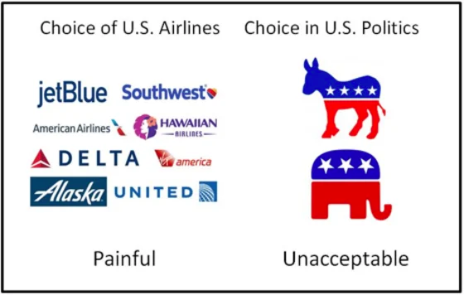
But as American political parties are concerned, not so much.
GOP and Democratic Party bosses don’t worry much about competition. The Democrats have staked out the liberal progressive half of the electorate, and the GOP gets everything over on the right. They only have to fight over the swing voters in the middle.
The Socialists, Greens, and Communists are typically stuck voting for Democrats just as Tea-Partiers, Libertarians, and Trump-nationalists are stuck voting GOP.
Sure, alternative parties exist in the US, but they don’t have elected representation, nor do independents -- approximately 43% of the electorate.
When elections come around, the “spoiler” hammer is wielded by the big two parties, who bludgeon would-be third-party or independent voters with lines like “a vote for Nader is a vote for Bush” or “a vote for Gary Johnson is a vote for Hillary.”
The tactics work, and many of us vote Democrat or Republican in the end, often fearing a worse outcome by voting for a favorite outside the two parties. You can almost hear Nancy Pelosi saying, “We don’t need to worry about Jill Stein’s voters—they will vote for us if they know what’s good for them!”
“Being the best” is no longer required. Our political parties in the US have instead become near-monopolistic, bloated behemoths whose only goal is retention of power.
The Democrats and GOP have the only two seats in the boat, and it’s pretty easy work for them to keep the struggling upstarts at bay.

But we are trained from a young age that the U.S. has a great constitution and a great system of government. As such, our normal American fervor for competition falls short of the outrage one might expect.
The vice-grip that our two political parties have over our state and federal governments is uncharacteristically acceptable.
Would Americans be more upset if they knew the statistics regarding other successful democracies?
The Organisation for Economic Cooperation and Development (OECD) is a group of 35 nations committed to democracy and market economies. I looked at the top ten nations in this group based on GDP per capita (arguably a measure of success) excluding the US -- which ranks eighth, by the way.
Here’s what I found:
- On average, these ten countries have more than eight parties with seats in their national legislature.
- No country had fewer than five parties with representation.
- The top two parties average just 60% of the total seats. A robust 40% of seats went to other parties (most) and independents (a few).

The OECD countries examined tend to skew on the smaller side, so I also looked at the Group of Seven (G7), comprised of the seven larger industrialized economies. Excluding the U.S., these countries boast an average often parties with representation nationally, and 24% of legislative seats outside the top two parties.
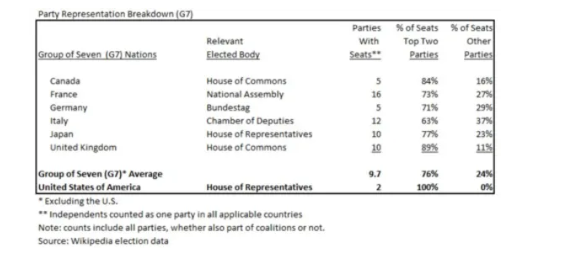
To put that in perspective, if the U.S. House of Representatives, which has 435 elected members, were on par with the other G7 countries, 104 of our congresspersons would be neither Democrat nor Republican.
They would instead represent a third party, fourth party, etc., or independents. To reach the top OECD nations’ average, that number would be a whopping 172.
In the US Congress elected in 2016, the number of representatives that are not Democrats or Republicans, is — wait for it — zero. (No space here, but I’ll be offering the full party breakdown of those zero seats in my next article.)
Now, in the United States, we elect one representative from each of 435 “single-member” congressional districts. We award that seat to the candidate with the most votes, even if it’s not a majority.
This is known as “plurality voting” or “first past the post” (FPTP). It’s also “winner-take-all” in that parties or independent voters whose candidate finishes second or worse get no representation in their district. Together, these are the key ingredients for the spoiler effect.
Comparing the U.S. electoral approach to the systems of the countries I examined, what differences or similarities do we see? What I found is as follows:
- 10 of the 14 observed (G7 and OECD) countries have multi-member electoral districts, where several representatives (often many) are elected from a given geographic area.
- All of the countries with multi-member districts also have proportional representation (PR) in the math of their seat allocation—if a district with PR has ten seats and 30% of the voters choose a party or its candidates, that party’s candidates get three seats. Thus, unlike the US, minority factions in this example get representation if their votes reach approximately 10%.
Countries with single-member districts (Australia, Canada, France, and the United Kingdom) have the greatest dominance by the top two parties.
- France and Australia have single-member districts, like the U.S., but do not use plurality voting (FPTP).
- France’s two-round approach has good multi-party success. In their system, a runoff of the top two candidates happens if there is no majority in the first round. This gives a majority outcome, and it removes the spoiler effect present in the U.S.
- Australia’s preferential (instant runoff/ranked choice) voting approach also defeats the spoiler effect, but through automatic runoffs based on voters’ candidate rankings. This also achieves a majority outcome but is slightly less effective in achieving seats outside the top two parties (and most electoral scholars concede that Australia is two-party dominant).
- Canada and the United Kingdom are the most two-party dominant of the observed countries (84% and 89% dominance by the top two parties respectively). Both have the one-two punch of single-member districts and plurality winners (FPTP). Of the countries I observed, these two are most like the U.S. in election of their legislative bodies.
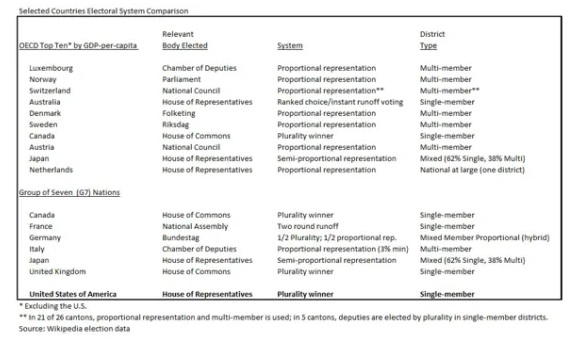
Beyond the benefits present with single-member districts and plurality winners, the Democratic and Republican parties have feathered their own nests as follows:
- Restrictive ballot-access laws that create barriers unfavorable to third party and independent candidates;
- Campaign finance laws allow virtually unlimited funding for parties, but severe limits for independent candidates;
- Gerrymandering power, efficient and computer-assisted, is vested in Republican or Democrat hands in most states; and
- An awesome fundraising infrastructure for ongoing gathering of vast pools of political support money (much of it from special interests) to be disbursed by party bosses to campaigns of promising party hopefuls like bets on the craps table.
It turns out that the structural benefits the parties enjoy combined with the laws they’ve passed protecting themselves are an awesome combination, limiting competition from other parties and candidates to pretty much zero.
Not only do the two parties have a 100% lock in the US House of Representatives, but this is mirrored with few exceptions across our 50 state legislatures.
Adding insult to injury, both parties have also received the benefits accorded to private associations.
The Democrats use superdelegates in their primary math and recently contended in court that even if they did favor Hillary over Bernie, it’s an internal party matter and none of the Court’s business.
The GOP has its own version of funky math to choose its presidential candidate.
The two choices we get in most elections—presidential or not--are the product of the rules determined by the leadership in each of the two parties. (I have previously referred to these as “country-club rules,” but this may be unfair to country clubs!)
Altogether, this is a shocking litany of abuse, America! WHERE IS THE OUTRAGE?
Let’s get back to the topic of electoral systems that allow more viable parties. Are you ready for multi-member districts and proportional representation, yet?
Well, you just may be in luck.
Rep. Don Beyer (D-VA) recently introduced a bill called the Fair Representation Act that will get you both. Beyer’s bill calls for three- to five-member districts, depending on the size of the state, and electoral math that results in proportional representation.
ALSO READ: Fair Representation Act: The Best Solution to Ending Partisan Gerrymandering
Were this bill to pass, even my conservative friends in San Francisco would likely gain representation in Washington. What a concept!
The two-party stranglehold is obvious, as is the corrosive effect that polarization continues to have on the business of governance.
The Fair Representation Act is a solution that works with the Constitution and will move us significantly in the right direction. It promises better representation, and probably will engender additional viable parties.
The trick of course (with this bill and others) is getting Democrats and Republicans in their safe, gerrymandered seats, to vote for electoral change.
What are you waiting for, America? Competition is the American way. That two-party duopoly is not going to tear itself down without you in its face.



